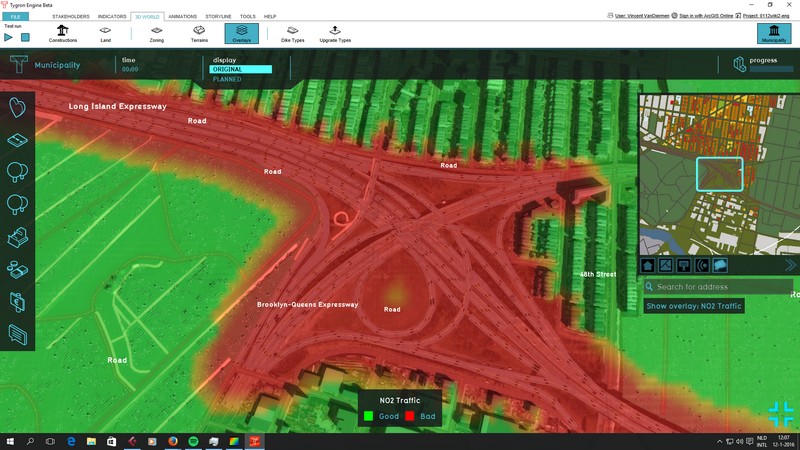Traffic NO2 Overlay: Difference between revisions
No edit summary |
|||
| Line 1: | Line 1: | ||
[[File:Traffic_NO2-Overlay.jpg|thumb|right|Traffic NO2 Overlay]] | [[File:Traffic_NO2-Overlay.jpg|thumb|right|Traffic NO2 Overlay]] | ||
The Traffic NO2 Overlay is a [[Grid Overlay]] which computes the impact of traffic air pollution (in μg/m³ NO2) for any given location in the [[3D World]]. The calculation takes into account the amounts- and types of traffic, and the distance from the source of emission. It also takes into account [[ | The Traffic NO2 Overlay is a [[Grid Overlay]] which computes the impact of traffic air pollution (in μg/m³ NO2) for any given location in the [[3D World]]. The calculation takes into account the amounts- and types of traffic, and the distance from the source of emission. It also takes into account [[Building|object]]s and [[Elevation model|terrain features]] which would block the travel of particles. | ||
The Overlay only takes into account NO2 emissions from traffic. Other sources of emissions (such as air traffic of factories) are explicitly excluded. | The Overlay only takes into account NO2 emissions from traffic. Other sources of emissions (such as air traffic of factories) are explicitly excluded. | ||
| Line 20: | Line 20: | ||
===Traffic=== | ===Traffic=== | ||
Traffic intensities for each type of traffic can be based on one of the following: | Traffic intensities for each type of traffic can be based on one of the following: | ||
* The [[ | * The [[Building attributes (Traffic NO2 Overlay)|Attributes of roads]] present in the [[3D World]]. | ||
* [[Prequels (Traffic NO2 Overlay)|Prequel Overlay]]s which define respective traffic intensities on a grid. | * [[Prequels (Traffic NO2 Overlay)|Prequel Overlay]]s which define respective traffic intensities on a grid. | ||
| Line 27: | Line 27: | ||
==Calculation== | ==Calculation== | ||
{{main|Traffic NO2 formula (Traffic NO2 Overlay)}} | {{main|Traffic NO2 formula (Traffic NO2 Overlay)}} | ||
The Traffic NO2 Overlay performs its calculations based on the [[Model attributes (Traffic NO2 Overlay)|Overlay's Attributes]], the presence of [[ | The Traffic NO2 Overlay performs its calculations based on the [[Model attributes (Traffic NO2 Overlay)|Overlay's Attributes]], the presence of [[Building|trees]], and the [[Building attributes (Traffic NO2 Overlay)|Attributes of roads]] present in the [[3D World]]. The calculations follow the standard rekenmethode 1 (SRM 1){{ref|srm1}}. | ||
==Results== | ==Results== | ||
Revision as of 15:07, 6 October 2022
The Traffic NO2 Overlay is a Grid Overlay which computes the impact of traffic air pollution (in μg/m³ NO2) for any given location in the 3D World. The calculation takes into account the amounts- and types of traffic, and the distance from the source of emission. It also takes into account objects and terrain features which would block the travel of particles.
The Overlay only takes into account NO2 emissions from traffic. Other sources of emissions (such as air traffic of factories) are explicitly excluded.
The Overlay implements SRM1[1], which is only applicable for urban environments.
Configuration
- Main article: Model attributes (Traffic NO2 Overlay)
The Traffic NO2 Overlay has a number of options which allow it to be configured as desired. A configuration wizard is available.
The following aspects can be configured:
- Base concentrations of NO2 and NOx
- Emissions per vehicle type both in motion and in traffic jam
- Constants for road-based dilution factors
- The hour(s) of the day to perform the calculation for
Traffic
Traffic intensities for each type of traffic can be based on one of the following:
- The Attributes of roads present in the 3D World.
- Prequel Overlays which define respective traffic intensities on a grid.
The traffic intensities can be defined as either a single value or as 24 hours, with each value corresponding to each hour of the day. The intensity used for the calculation is then defined by the HOURS model Attribute.
Calculation
- Main article: Traffic NO2 formula (Traffic NO2 Overlay)
The Traffic NO2 Overlay performs its calculations based on the Overlay's Attributes, the presence of trees, and the Attributes of roads present in the 3D World. The calculations follow the standard rekenmethode 1 (SRM 1)[1].
Results
The following result types are available as output from the traffic NO2 calculations:
| Icon | Result type | Unit | Mode | Description |
|---|---|---|---|---|
| CONCENTRATION | μg/m3 | The concentration of NO2-equivalent pollution as a result of traffic. | ||
| EMISSION_NO2 | μg/m3 | The calculated emissions of NO2 due to traffic. | ||
| EMISSION_NOX | μg/m3 | The calculated emissions of NOX due to traffic. | ||
| TREEFACTOR | factor | The presence of trees (within 30 meters) as a fraction and converted to a factor between 1 and 1.5. | ||
| TREES | boolean | The presence of trees in any given location specifically. |
Notes
- The Overlay calculations are based on Standard Calculation Method 1 (SRM1) as defined by the dutch government.[1].
How-to's
- How to add and remove an Overlay
- How to edit an overlay legend
- How to add a static traffic model
- How to add a static grid-based traffic model
- How to add traffic data unaligned with roads
- How to add a dynamic traffic model
References
- ↑ 1.0 1.1 1.2 SRM1 ∙ Regeling beoordeling luchtkwaliteit 2007, Bijlage I ∙ Found at: http://wetten.overheid.nl/BWBR0022817/2013-01-01#Bijlage1 ∙ (last visited: 16-02-2022)
